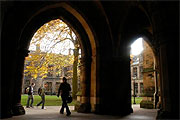Source: Wellcome Library, London (Ref M0010124)
Notable People
Sir William Boog Leishman
-
William Boog Leishman

-
William Boog Leishman

Source: Wellcome Library, London (Ref M0003302)
-
William Leishman's matriculation record, 1881

Source: University of Glasgow
Bacteriologist
Born 6 November 1865, Glasgow, Scotland.
Died 2 June 1926.
A celebtrated bacteriologist, he discovered the cause of the disease later named Leishmaniasis.
Connection to the University of Glasgow: Graduate, Honorary Graduate
GU Degrees: MB CM, 1886; LLD, 1914;
Honours: CB; KCB; KCMG;
Discover more Bacteriologist on the University of Glasgow Story website
Achievements
The following achievement is associated with Sir William Boog Leishman:
Discovering of cause of Leishmaniasis
Leishmaniasis is a tropical disease named after the William Leishman who discovered its cause in 1900.
Honours
The following honours are associated with this person:
Biography
Professor Sir William Boog Leishman was a Glasgow graduate and a distinguished bacteriologist and pathologist who gave his name to a disease, Leishmaniasis, the cause of which he discovered.
Leishman was born in Glasgow in 1865 and was the son of William Leishman, the Regius Professor of Midwifery at Glasgow from 1868 until 1894. He was educated at Westminster School and matriculated at the University of Glasgow in 1880, at the age of fourteen, to study Greek, Latin and Maths. He began his medical studies in 1882 and graduated with an MB CM in 1886 with High Commendation, but had to wait until November to comply with the Faculty age regulations.
After graduation he joined the Army Medical Corps and served in India, returning to work at the Army Medical School at Netley. It was while he was an assistant Professor there in 1900 that he identified the causative parasite of Dum-dum fever (now known as leishmaniasis). After the war he became the first Director of Pathology at the War Office and later Medical Director of the army medical services.
Among many honours, he received an Honorary LLD from the University of Glasgow in 1914. He was created Companion of the Order of the Bath (CB) in 1915, Knight Commander The Most Honourable Order of the Bath (KCB)in 1924, Knight Commander of the Order of St Michael and St George (KCMG) in 1918. He died in London on 2 June 1926.

